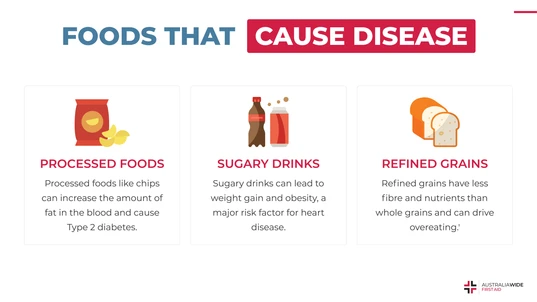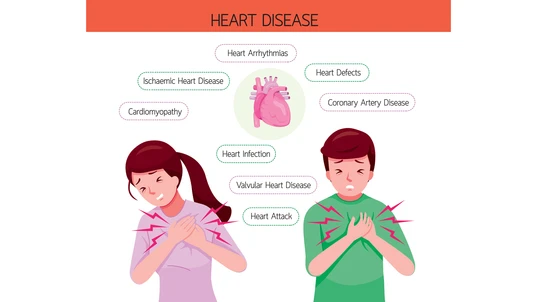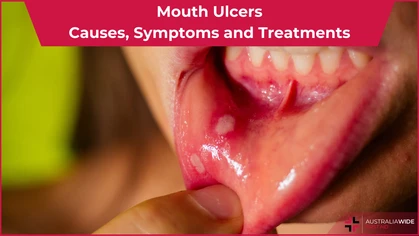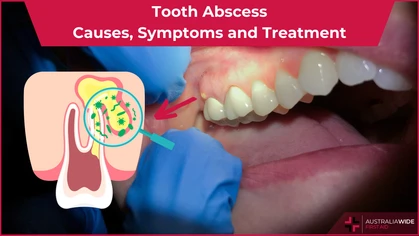4 Diseases You Can Prevent with Healthy Eating

General Health-Related

The Australian Guide to Healthy Eating provides recommendations on the types and amounts of food to eat each day for optimal health. By following the Australian Guide to Healthy Eating, you can also reduce your risk of several chronic diseases.
To maintain an overall healthy wellbeing, eating well and providing your body with the necessary nutrients is very important. Through the foods we eat, it not only makes our bodies stronger, but also prevents major diseases from developing. In this article, we’ll be going through the importance of healthy eating practices and how we can reduce our risk of certain health conditions.
Broadly speaking, to eat healthy is to enjoy a varied, nutritious diet comprising foods from each of the 5 food groups, as recommended by the Australian Guide to Healthy Eating. These recommendations are conducive to good health.
What is Healthy Eating?
Healthy eating is essentially eating a wide variety of nutritious foods that we need to eat for good health. The Australian Dietary Guidelines and Australian Guide to Healthy Eating outlines this by encouraging people to eat a wide variety of food from five major food groups. The following food groups are:- Vegetables and legumes or beans
- Fruit
- Grain (cereals) foods, mostly wholegrain and/or high cereal fibre varieties
- Lean meats, poultry, fish, eggs, tofu, nuts and seeds, and legumes or beans
- Milk, yoghurt, cheese and/or alternatives mostly reduced fat
- Sweet drinks such as energy drinks, fruit drinks, soft drinks, and cordials
- Sweet pastries such as cookies, cakes and doughnuts
- Savoury foods such as pizza, meat pies and potato chips
- Processed meats such as bacon and ham
The Dangers of Obesity
According to the World Health Organization (WHO), obesity is defined as an abnormal or excessive fat accumulation that presents itself as a risk to our health. WHO defines an adult to be overweight and obese as follows:- Overweight is a body mass index (BMI) greater than or equal to 25; and
- Obesity is a BMI greater than or equal to 30.
- Cardiovascular diseases such as heart disease and stroke,
- Diabetes,
- Musculoskeletal disorders such as osteoarthritis, and
- Some cancers such as breast, ovarian, prostate, liver, kidney, and colon cancer.

Cardiovascular diseases encompass disorders of the heart and blood vessels. Common types of cardiovascular disease include coronary heart disease (heart attack and angina), as well as cerebrovascular disease (stroke).
The Dangers of Cardiovascular Disease
Cardiovascular diseases (CVDs) are a group of disorders of the heart and blood vessels. These include coronary heart disease, cerebrovascular disease, and peripheral arterial disease. These can result in heart attack and strokes due to the blockage that prevents blood from flowing to the heart or the brain. According to WHO, the reason for this blockage is a build-up of fatty deposits in the inner walls of the blood vessels that supply the heart or the brain. The development of CVDs is gradual and one major risk factor is consuming an unhealthy diet and the harmful use of alcohol. Examples of some foods that increase your risk of CVDs include:- Processed meats – they contain a high amount of salt and are high in saturated fat
- White bread, rice and pasta – these refined grains are often missing important nutrients such as healthy fibre, vitamins, and minerals
- Alcohol – heavy drinking can cause high blood pressure, heart failure, strokes and weight gain
- Sugary drinks and snacks – these are generally high in sugar, calories and saturated fat that can increase your triglycerides and lead to a heart attack

Type 2 diabetes is a chronic condition in which the body's ability to regulate and use glucose (sugar) as a fuel is impaired. People with Type 2 diabetes need regular injections of insulin to maintain their blood glucose levels within acceptable ranges.
The Dangers of Type 2 Diabetes
Type 2 diabetes is defined as an impairment in the way the body regulates and uses sugar (glucose) as a fuel. The long-term risk of type 2 diabetes results in too much sugar circulating in the bloodstream which can lead to high blood sugar levels and other disorders of the circulatory, nervous and immune systems. Generally, you are more likely to develop type 2 diabetes if you are not physically active and are overweight or have obesity. This extra weight can sometimes cause insulin resistance which results in high blood sugar levels and is common in people with type 2 diabetes. By maintaining a healthy diet, eating moderate portions and drinking plenty of water, you’ll be able to lose the extra weight that can cause insulin resistance. Foods such as fruits, vegetables, whole grains, legumes, and beans are great foods that are not only nutrient-dense but contain fewer calories than discretionary foods that are more likely to increase your risk of type 2 diabetes. Examples of foods to include in your diet are:- Nuts and seeds (such as almonds, walnuts, chia seeds)
- Protein-rich foods (such as seafood, tofu, tempeh)
- Heart-healthy fats (such as olive oil, avocado, sesame oil)
- Beverages (water, black coffee, unsweetened tea, vegetable juice)
- Full-fat dairy (such as whole milk, butter, cheese)
- Sweeteners (such as sugar, brown sugar, honey, maple syrup)
- Processed foods (such as chips, processed meat)
- Trans fat (vegetable shortening, dairy-free coffee creamers, fried foods)
The Dangers of Cancer
According to WHO, cancer refers to the large group of diseases that can start in almost any organ or tissue of the body when abnormal cells grow uncontrollably. They often go beyond their usual boundaries to invade adjoining parts of the body or spread to other organs. And the foods we eat can greatly affect our risk of developing certain types of cancer. High-energy and high-fat diets can lead to obesity and is generally thought to increase the risk of some cancers. As described in the Australian Guide to Healthy Eating, enjoying a wide variety of nutritious foods can greatly reduce your risk of cancer. By consuming foods high in fibre, vitamins, minerals and antioxidants, it may help decrease your risk of cancer in particular areas of the digestive system such as the mouth and stomach. Grains such as oats, brown rice, corn and lentils are also an excellent source of fibre that provide protective benefits against cancer. Citrus fruits such as oranges, grapefruit and lemons are also recommended due to the plant compounds and vitamins packed in every bite. On the other hand, a diet that contains ‘discretionary foods’ with high fat, high sugar, and low fibre may increase the risk of many cancers including bowel, lung, prostate, and uterine cancers. Heavily salted food has been proven to increase the risk of stomach cancer as well due to the high level of sodium or sodium chloride.Final Thoughts
By eating a healthy diet and consuming the right proportions according to your lifestyle needs, your risk of developing certain health conditions can be significantly reduced. To learn more about how you can proactively manage your health and wellbeing through the foods you eat every day, sign up for our Accredited First Aid Course and begin your journey now.
Originally published at
https://www.australiawidefirstaid.com.au/resources/eating-healthy-can-prevent-what-diseases
as part of the Australia Wide First Aid Articles Library









